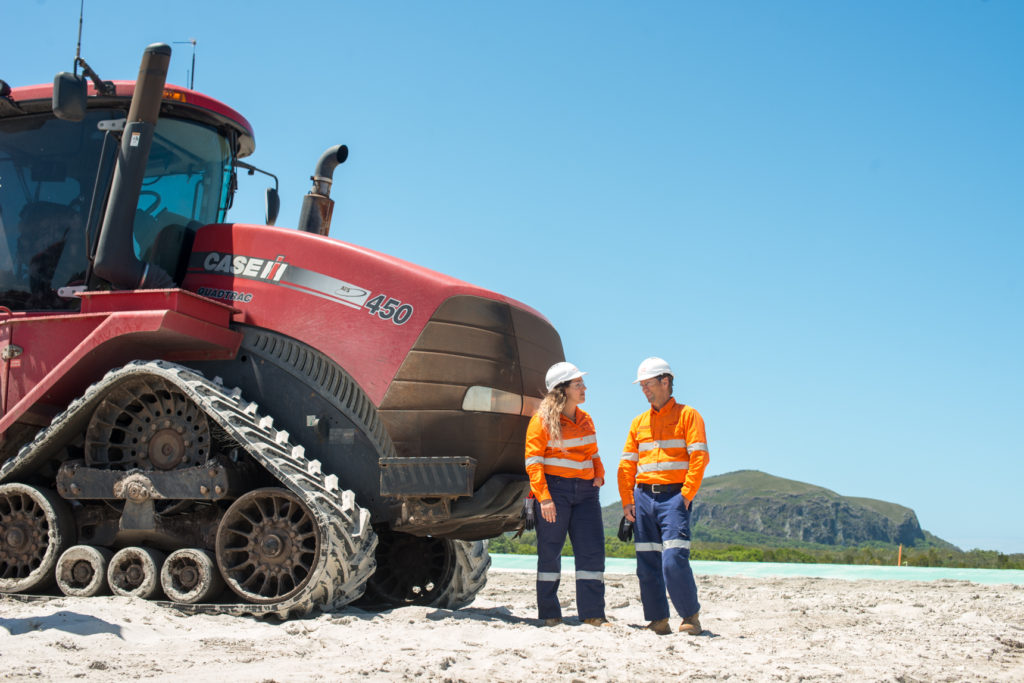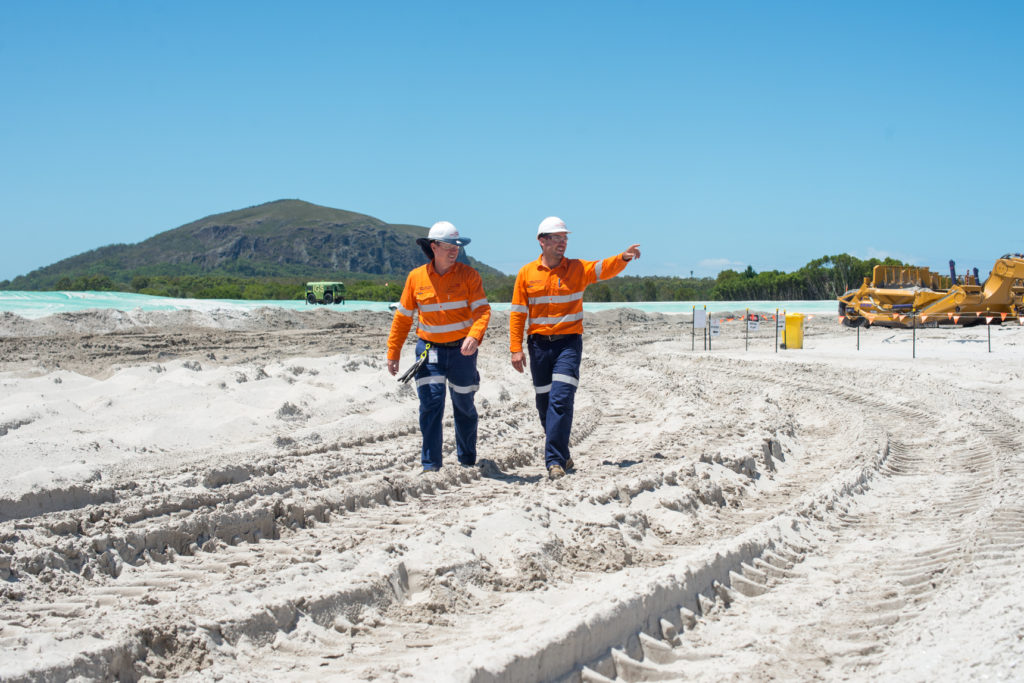Background
| Location | Sunshine Coast Airport, Marcoola Queensland Australia |
| Service | Soil Erosion Control – Wind and Water |
| Products | GRT: Soil-Loc, and GRT: Enviro-Binder |
| Duration | October 2019 – April 2020 |
| Status | Project complete and operational |
The largest Sunshine Council project ever undertaken, the Sunshine Coast airport expansion enabled visitors from international destinations to enjoy the region and to transform the economy.
The project consisted of:
- A 2,450m long runway
- Half runway length Taxiway
- Terminal and Apron expansion.
The expansion works fringing environmentally sensitive mangroves and tidal swamps required delicate interaction with the natural surroundings. The airport bordered by the Coolum National Park recognized as having ‘Very High’ ecological values as habitat for endangered, vulnerable and rare species.
The level of care required in reducing the impacts of such a significantly sized civil project was successfully adopted in the control of the friable sand disturbed during groundworks and eroded by wind and rain. Sediment loading to adjacent waterways, which may impact marine life and water quality, was also closely managed during tidal surges and frequent rainfall events typical for the region. GRT, leaders in providing the most recently developed technologies, and environmentally sustainable sediment and erosion control solutions were called upon to offer an effective, economic solution, achievable within these constraints.
Global Road Technologies solution, successfully provided product for the treatment of over 600,000m2 of disturbed sand with the supply of 6,000 litres of GRT: Soil-Loc.
Are environmental regulations, health and safety concerns or potential profit loss a concern right now?

Challenges
- Wind: Seasonal winds directly off the Pacific Ocean blow regularly at speeds of in excess of 20knots. These winds had the potential to carry sand offsite onto adjacent lands causing concerns to neighbours, infrastructure and the environment for distances of up to 5 kilometres. There was also a danger of sand intake to aircraft operating on the existing airstrip and on windy days flight being restricted due to construction exposed sand being blown around.
- Rain: Generally stormwater will dissipate very quickly through the sand where it rarely accumulates and travels in large quantity to cause scaring/erosion and transport silts into waterways. However, at sites that fringed the sandy formation where tidal surges and stormwater would intercept, there was the potential for sand to be carried and deposited onto vegetation, suffocating important plant life. The possibility of overloading waterways with slits from these areas was a constant concern were traditional silt and erosion control methods often failed to provide the protection necessary.
- Product Scrutiny: A prequalification process required for all products introduced onto the project conducted by a third party was necessary as a protective measure for the surrounding sensitive ecosystem. Products intended for broad-scale application such as GRT’s products necessitated particularly intensive investigation. Following a lengthy process of information exchange, both GRT: Soil-Loc, and GRT: Enviro-Binder were approved for use.
- Dosing Equipment: Following preliminary testing, it was recommended that GRT: Soil-Loc be diluted at 1 part to 2,000 parts water. Challenges face for the task were:
1) Safe dosing into the truck without climbing up onto truck tanks or working at height
2) Adaptable to existing truck fill point
3) Pump capable of pumping up to 10litres/min
4) Product viscosity >20.5mm2/s
5) No power available at the fill point
Automation required to regulate consistent dosing into a number of water truck sizes.
- Trace Marker: The client required some form of indication that a product had been applied. In order to do this with GRT: Enviro Binder, for example, it was a simple matter of adding a pigment. The nature of film-forming products enables the use of pigments without running the risk of transportation in water in rain events and into the surrounding environment. Film-forming products locked the pigment in as part of the polymerization process. GRT: Soil-Loc is a long-chain polymer but with a different characteristic that forms a relatively coarse mat and does not coalesce which is an important attribute that enables GRT: Soil-Loc to be an economical and environmentally sustainable product ideally suited for binding soil particles together without an imposing residue that may not breakdown in the required time frame.
GRT was able to provide a solution with the introduction of a marker dye. Following extensive testing in the GRT laboratory of a number of proprietary products designed as markers for herbicide application, a solution was provided that gave the client the ability to provide definition where GRT: Soil-Loc had been applied. Being non-cumulative, and non-toxic, the solution also met important ecological conditions by offering highly biodegradability characteristics.
Objective
The brief as communicated to GRT was to provide a cost-effective solution to contain sand-drift within the limit of works while: meeting a tight budget, complying with ecological conditions, being deployable at short notice, but above all, it must work for several months at a time. This list of constraints automatically drew focus to GRT: Soil-Loc as the ideal product.

Field Trial
Notwithstanding the rigours of environmental and budgetary constraints, the client also required a field test to be absolutely sure they were committing to the best available technologies to deal with the unique set of restraints presented with this project.
Proposal
Upon acceptance of the products ability to provide the desired outcome in addressing:
- Durability Concerns
- Ecological constraints on toxicity
- Economical constraints
- Practicality concerns
- Customer support
GRTs proposal was accepted in the supply of the product, supporting hardware and technical support.
Results
- No more complaints from neighbouring properties about nuisance dust
- No conformance infringements upon the surrounding habitat
- Complete control of sand drift
- Aircraft restrictions eased
- Successfully and easily deployed with supporting hardware provided by GRT
- Unprecedented sediment and erosion control technology
- Controlled and predicted costs
Your feedback is important to us. If you enjoyed reading this Global Road Technology industry update and found it informative, please let us know by leaving a REVIEW.
Troy Adams
Troy Adams is the Managing Director of Global Road Technology (GRT) Specialising in Engineered Solutions for Dust Suppression, Erosion Control, Soil Stabilisation and Water Management. A pioneering, socially conscious Australian entrepreneur, Troy Adams is passionate about health and safety and providing innovative solutions that are cost-effective to the mining industry, governments and infrastructure sectors. Troy is also a tech investor, director of companies like Crossware, Boost, Hakkasan, Novikov and more.
MORE INDUSTRY ARTICLES
Nothing found.